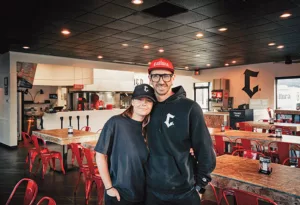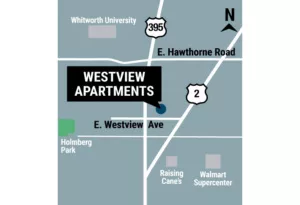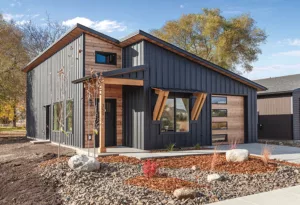
Home » SNAP Financial Access expects loan volume to hit $700K this year
SNAP Financial Access expects loan volume to hit $700K this year
Total volume increased, defaults declined in '15

February 25, 2016
SNAP Financial Access, a community development financial institution here, saw a 26 percent increase in loan volume last year and hopes to continue its goal of providing small business development resources through new programs and partnerships, a program representative says.
SNAP Financial Access offers classes, workshops, and coaching on small business development, money management, and credit counseling, and also makes loans.
Kerri Rodkey, SNAP’s director of financial stability, says the lending services program has made 324 business loans worth $3.2 million here since 2005. Of those, only 29 loans totaling about $150,000 have been written off for a loss.
The program made 34 loans totaling about $627,000 last year, up from 27 loans for $500,000 in 2014, Rodkey says. So far this year, the program has made four loans totaling $20,900, and it has five loans awaiting approval. Rodkey estimates the program will make at least 40 loans this year, totaling about $700,000.
“The majority of people we lend to are low-income individuals or businesses providing jobs to low-income people,” she says. “Our goal is not just to get them the money they need now, but also to prepare them to use more traditional lending sources in the future.”
SNAP Financial Access is a subsidiary of Spokane Neighborhood Action Partners, a nonprofit community action agency headquartered at 3102 W. Fort George Wright Drive.
The program began in 1997 as a partnership with the Northwest Business Development Association, the U.S. Small Business Administration, Small Business Development Center, and the city of Spokane. By 2005, it was lending on its own, and it received its community development financial institution certification in 2006.
SNAP Financial Access is involved in two areas of business development: lending services and the Women’s Business Center, a resource center here for small business training, consulting, capital, and networking opportunities.
As part of its lending services, SNAP Financial Access offers small loans, known as micro-loans, to low-income individuals and business owners.
Loan amounts range from $500 to $75,000, including combined funding sources, depending on loan products chosen and what the borrower is qualified to receive. She says the average loan amount per applicant is about $20,000.
According to Rodkey, about two-thirds of the program’s borrowers are established businesses, with one-third being startups. As for business longevity, she says the program has a high success rate, with 80 percent of businesses that borrowed from SNAP Financial Access in the last five years still operating.
“It’s commonly thought that 80 percent of businesses fail within the first five years,” she says. “But our system of consulting and assistance resources has actually documented the opposite, having helped 75 to 80 percent of our borrowers succeed in those first five years.”
Rodkey credits that success to the program’s commitment to walking borrowers through the lending process and giving them access to resources that will grow their business.
“Our default rate was 2 percent last year,” says Rodkey. “The industry standard is 9 percent or less for most micro-lenders. The highest we ever saw was 7.5 percent, but that was during the height of the financial crisis.”
The program’s lending services include access to numerous loan products ranging from 0 percent interest to 8 percent, with one- to five-year terms. Products include microenterprise loans, small business loans, refugee loans, green business loans, credit builder loans, East Sprague business improvement district loans, and youth entrepreneurship program loans.
Interest rates are 3 points above prime or a minimum of 8 percent, with discounts in certain circumstances.
“Loan funding can be very specific, according to number of employees, amount of income, refugee status, etc.” says Rodkey. “When someone comes to us needing a loan, we work with them to determine their needs, come up with a plan, and put in a proposal to our loan committee. The committee reviews those materials and decides whether to grant the loan.”
While most who apply are granted a loan, Rodkey says some applications are denied, while some applicants realize they’re not ready and plan to reapply later.
“We’re more flexible than most banks in our credit analysis,” says Rodkey. “We don’t require a minimum credit score, but we do like for borrowers to have a strong business or idea for new business, and expect them to demonstrate a responsibility in managing their debt.”
Rodkey says borrowers also are expected to pledge some type of collateral, although the type and amount is flexible.
She says microloans will be considered for anything necessary for business growth and development. These uses would include things like working capital or purchasing inventory, supplies, furniture, fixtures, machinery or equipment relating to business operations.
A microloan can’t be used to purchase real estate or pay existing debts, although the program does sometimes consider refinancing existing debt if borrowers can show it would benefit their businesses significantly.
Rodkey says the program receives borrower referrals through financial institutions, other SNAP departments, and its website.
She says SNAP Financial Access lending services is one of the only SBA intermediary lenders that she knows of in Spokane County, although there may be others serving Eastern and Central Washington.
In addition, the program receives loan funding from the city of Spokane, Spokane County, U.S. Department of Health and Human Services office of refugee resettlement and community economic development programs, the Northwest Business Development Association, the U.S. Department of Treasury’s Community Development Financial Institutions Fund, and Spokane-based Avista Utilities.
“Northwest Business Development was the source for all our loan funding from 1998 to 2004,” says Rodkey. “All the other sources came along after 2004.”
Although she has been with SNAP for 10 years, and also serves as a leader for several economic and small business development programs in the community, Rodkey says she intends to retire this July.
“My husband and I are joining the Peace Corps, and will be traveling to Botswana to serve as volunteers for the next two years,” she says.
Rodkey says she’s been gradually pulling back from her community leadership roles this year, but intends to get back involved in some of those organizations upon her return to the area.
SNAP’s current business development coordinator, Cameryn Flynn, has worked alongside Rodkey for a year, and is one of the candidates applying for her position once it becomes available.
“It is a very open and competitive process,” says Flynn.
Originally from Clarkston, Flynn attended Spokane Falls Community College and Gonzaga University, earning a bachelor’s degree in business administration. She also holds a master’s degree in psychology from Antioch University, of Seattle, and worked on microenterprise and English as a Second Language projects in east Africa for three years prior to starting at SNAP.
Flynn says she sees the program continuing to build on its partnerships while working to spread the word about funding opportunities such as the youth entrepreneurs program and the East Sprague business improvement district.
“Our youth entrepreneurs program offers 3 percent interest loans to young adults ages 18 to 24. We also are offering interest free small business loans to those starting or expanding businesses in the East Sprague business improvement district, as part of an ongoing effort to encourage development and improvements to that area of the city,” says Flynn.
Rodkey says the community’s needs determine the program’s ongoing goals.
“There’s such an awareness and commitment to growing from within,” she says. “This community really embraces the idea of creating jobs and building the economy for those who are living here.”
Flynn agrees, saying, “This program is part of a larger ecosystem of information and services. It’s so wonderful to drive through our neighborhoods and see businesses and individuals who got their start here flourishing.”
Latest News Up Close Banking & Finance
Related Articles
Related Products



